My garden emulates a wet prairie and gets off to a very slow start in spring and early summer. This is a challenge I'm working on. Its peak is mid-July through October, as demonstrated by the large numbers of images taken in those months. (Warning, there are over 100 photos in this post.)
February
Rime frost in early February...



Completion of the stone wall at the base of the house...



Beginning the pond...

Chasmantheum latifolium outside the house...



Progress on the pond ...

April
Early April (just to show how bleak April can be). This looks especially dismal because, as is appropriate with a prairie, I burned many of the grasses, leaving ashen smudges that remained until new green growth emerged ...

May
Finished pond, dogwoods blossoming (the red posts have been replaced by stone wall) ...



A hawk waiting above the pond ...

A 40-year-old crab apple still going strong even in the shade of a sycamore ...

Sweet woodruff and myrtle, planted when the house was built in the mid-60's ...
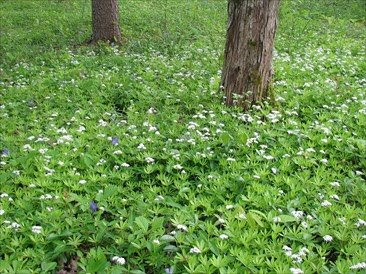
Ligularia japonica, from Tony Avent's Plant Delights. Extraordinary foliage. I may have to get several more ...

A native Scirpus amid Equisetum arvense ...

Native Sensitive fern ...

Another native, Juncus ...

A green walk at the wood's edge ...

After two years, Silphium perfoliatum seedlings are maturing ...

Euphorbia palustris ...

Iris versicolor, planted en masse, is a first attempt at early color...

And Iris pseudacorus ...

Siberian iris ...

Emerging leaves of Silphium terebinthinaceum ...



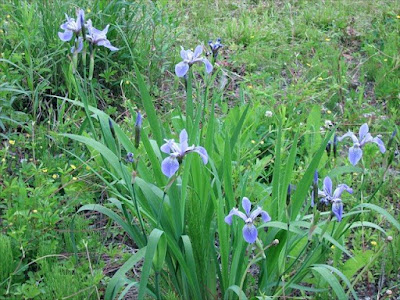

Looking across the garden. The ragged cedars were cleaned up later in the season ...




July
The high summer perennials are growing rapidly in early July. The tallest is Filipendula rubra 'Venusta' still without flowers ...

Lysimachia ciliata, Monanda 'Jacob Kline', and Rudbeckia maxima in front ...

The pond, cloudy with algae. It cleared about two weeks later ...

Rudbeckia maxima ...


The Filipendula in bloom. I actually like it better when the pink fades to copper tones ...

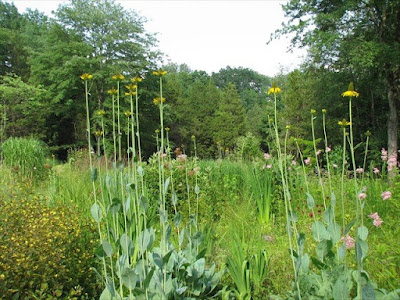






Near the end of July the Joe Pye Weed has come into bloom ...

Silphium laciniatum ...


Ernst, to give a sense of scale ...

A tall form of white Physostegia (Obedient plant) that I hope will also become a groundcover ...

Pycnanthemum muticum turns a velvety white; its fragrance attracts thousands of bees and wasps ...


Silphium terebinthinaceum. I planted plugs three years ago. They form huge, beautiful leaves, but this is the first to bloom ...




Late July view towards the house. Its simple, low profile blends well with the woodland and garden ...

Pycnantheum muticum, Petasites hybrid and Miscanthus 'Silberfeder' in a combination 'borrowed' from an Ohme and Van Sweden design ...


Increasing complexity - Rudbeckia maxima, Joe Pye Weed, Vernonia, Eupatorium cannibinum (a European form of our Joe Pye Weed), Silphium laciniatum, Miscanthus purpurescens ...
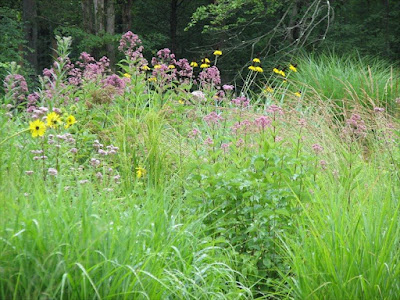



August
We introduced one summer weed cutting with a string trimmer this year, in early August. It takes a steady hand to avoid the closely spaced perennials. It's the best way to cut down the invasive Japanese Stilt Grass before it makes seed, yet it's late enough to avoid harm to desirable seedlings. Some hand pulling is also required.
Below Liatris pycnostachya adds its wands of purple (the photo color isn't true) in early August ...

Note the coppery color of the aging Filipendula inflorescences. Much better than cotton candy pink ...



Sanguisorbas begin flowering ...


Lobelia cardinalis ...

Physostegia virginiana and Patrinia scabiosifolia with the big leaves of Silphium terebinthinaceum ...


Innula racemosa 'Sonnerspeer' just planted this year, already in bloom ...

Sanguisorba canadensis ...
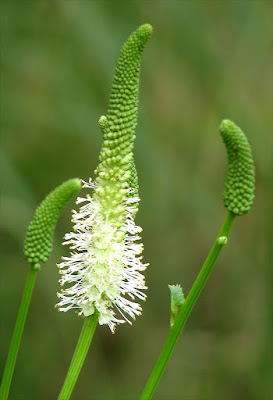


Lobelia siphilitica (Great Blue Lobelia) ...

Joe Pye Weed, Eupatorium perfoliatum (boneset), Vernonia from seed ...




September
The bank looking up to the house - Viburnum plicatum tomentosum 'Mariesii', Miscanthus gracillimus, Pycnanthemum muticum ...



One of many native asarums ...

A colony of Lobelia cardinalis ...






October














December





Looking across the garden. Compare the cedars (Juniperus virginiana) here to the messy ones in the spring photo taken from the same point of view. Removing the messy lower limbs has opened the space, making room for a new part of the garden ...

The new stone wall, finished just this fall ...



Partially completed steps from the house into the garden ...

Ilex verticillata (winterberry holly) ...






What a rare and wonderful treat, a tour of your spectacular gardens through the changing of the seasons..... almost like a changing of the guard as it were with the amazing variety of plants that you grow to amazing success! I, an urban dweller am so jealous of those who have a panoramic tapestry such as this to create with. Simply spectacular!
ReplyDeleteThis is a very specially enjoyable post. I will remember it. (Just as I remembered some of my favourite moments from your gardening year as I scrolled down the screen.)
ReplyDeleteThere's a nice sense of the world going round - and of completion - as it lands one back into winter again.
I'm not a special fan of slide-shows but, if you were able to include one with this sequence of photos on your blog, I would really like to watch the year go by . . . and by . . .
Thanks for the warning at the top of the page about the number of photos too. It meant I waited for it to load properly before starting to look and knew in what frame of mind I should go down the post.
Lovely.
Lucy
Teza,
ReplyDeleteI gardened for many years in a 16 by 20 foot vest pocket garden in Brooklyn. I agree having the space to do more is fun, but it's almost too much, especially for one who can garden only on weekends. But I'm grateful.
Lucy,
ReplyDeleteI feared I had used too many pictures; I admit a slide show would be better in some respects. But I'm also using this blog as a kind of garden diary, and by simply listing the photos in the blog I can return to make additional "notes" about what I want to change, what I want to continue. Perhaps I can do an alternate post using a slide show. Thanks for the idea.
A beautiful space - puts me in a better frame of mind just looking at the photos, must be amazing to walk out in at the end of a long day.
ReplyDeleteOh! I definitely, definitely didn't mean instead of what you have here. It's good to be able to look through the pictures at one's own rate . . . and, as I said, I don't usually like slide shows much. But with your year, I felt that, as well as this, it would also be good to see the pictures glide by. Certainly, this is best. A slide show would simply be an extra.
ReplyDelete(Still nice though.)
Lucy
Wow, what a wonderful tour. I can just imagine all the insect and animal life you've attracted to your garden. It looks so natural and beautiful.
ReplyDeleteNewShoot,
ReplyDeleteAll photography lies; I'm not showing much of the unfinished or ugly. When I walk out in the summer and fall, I'm often overwhelmed with the projects I haven't done. This is unavoidable since I can only garden on weekends. But when I walk in the garden now, in mid winter, with all the plants flattened under show and ice, I really enjoy it more - the crisp sounds, the sharp air, the clear way of seeing big picture changes that need to be made.
Jean,
ReplyDeleteFrogs, I get lots of frogs since I finished the pond, and absolutely NO mosquitoes. Many butterflies, bees and wasps. This area is woodpecker territory, we even see pileated woodpeckers from the windows of the house. Foxes, many wild turkies, I think coyotes, and of course countless deer. Hawks, a Great Blue Heron infrequently. Not as many birds as in my former garden in Rosemont, which was open on all sides, with big sky. Here at Federal Twist, the surrounding woods seems to attract fewer birds. They come erratically in bunches, then there can be few for days on end.
You and I have the same problem: my garden is vastly more interesting to me from August to October--of course, this is my favorite time of year, too. I've worked so hard to have good fall color and late bloomers, I've almost neglected May and June... just have irises, some sanguisorba, a few non natives. I'm glad to see Lysimachia ciliata gets so fine--I have a small colony started and look forward to the foliage and more blooms. We have many of the same plants. Maybe I'm stalking your plants.
ReplyDeleteWell you live in prairie country, or at least where prairie used to be. I'm trying to create a wet prairie. Only makes sense we use many of the same plants. The Lysimachia ciliata is highly competitive and spreads rather rapidly, so you'll probably have a lot more this year than last. I love the early color, and want to establish several large colonies. For more early color, I want to add daffodils, which the previous owner left in large quantities, just not in the place I put my garden, and some of the early water-loving things like Caltha palustris. I'll probably plant anything with palustris in its name.
ReplyDeleteAn amazing and wonderful garden, and such a treat to see it through the seasons. Thank you! I noted Iris versicolor and Rudbeckia maxima especially. Gorgeous.
ReplyDeleteWow! This is the longest post I have ever read, -eh seen.
ReplyDeleteSo many beautiful pictures and some interesting plants. And the stone wall suits the place. Love it :)
Hilde
J, Rudbeckia maxima is a great plant.
ReplyDeleteHilde, I'm happy you visited. I believe you said you are the most northern blogger on Blotanist. How far are you from the Arctic Circle?
ReplyDeleteI think it's about 350 km to the arctic circle from where I live(Tromsø)
ReplyDeleteDriving distance is 600..
Amazing what you can do gardening so far north, but I remember seeing some quite beautiful gardens when I visited Iceland. I quite enjoyed the Reykjavik Botanical Garden. Come to think of it, I should do a post on my visit there.
ReplyDeleteHi James,
ReplyDeleteI'm just finding this post, just cluing in. Thanks so much for actually following through on my impulsive suggestion! Your generosity and thoughtfulness continues to amaze...as is this spectacular young garden you've been constructing. I'm so looking forward to being able to watch it happen again this spring. It's a pleasant thought. And it'll be even bigger, stronger, and clearer as well, won't it? Such a pleasant thought.
Best,
Peter Holt
Hi Peter,
ReplyDeleteWe'll see what this spring brings. Just got back from South America yesterday. Today I burned many of the large grasses in preparation for spring work.
James,
ReplyDeleteIs the grass burning about evoking the spirit of the original prairie or is it a practical, labor-saving concern? What's your technique? Do you use lighter fluid to speed things along or do the grasses burn well without chemical help? Are you burning large areas or individual clumps?
Questions, Questions...
Peter
James, what a wonderful garden! It is wonderful how you have captured the different seasons. If it were not for the stone walls and the evergreen trees in the back you may not realize it is always the same garden. Beautiful balance! The pictures were so beautiful that i never realized they were around a 100.
ReplyDeletePeter,
ReplyDeleteNow I like the idea of evoking the spirit of the prairie by burning grasses. I wish I could answer yes. Perhaps I should lie, but it's in fact a practical, labor-saving measure. I use a flame tourch, available at any hardware store. The grasses are mainly planted in bunches, so I can easily control the burn and limit it to one spot at a time. I burn the miscanthus first because it seems to have a lot of biomass and create a very hot file (for only a minute or two). I'll burn the less massive grasses such as panicums separately. I have to be very careful to avoid damaging trees and shrubs because the hear can easily kill them. A clear demonstration of why fires made prairies possible.
Amalia,
ReplyDeleteSo you discovered the "longest blog post in the world"! Peter Holt (see above) suggested I do a review of the garden over the year. I now realize I included a few photos more than once. I need to remove those. Thank you for the compliment. I do want to work on improving the appearance of the garden in the spring and early summer. There's not much to look at, not much of sustained interest, until the middle of July. I need more structure, and more open space in the fall when the garden is simply too crowded.